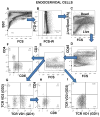Loss of Intra-Epithelial Endocervical Gamma Delta (GD) 1 T Cells in HIV-Infected Women
- PMID: 26666220
- PMCID: PMC4715976
- DOI: 10.1111/aji.12458
Loss of Intra-Epithelial Endocervical Gamma Delta (GD) 1 T Cells in HIV-Infected Women
Abstract
Problem: Human gamma delta (GD) T cells play a well-documented role in epithelial barrier surveillance and protection. Two subsets of GD T cells, defined by the use of either the Vdelta2 (GD2) or Vdelta1 (GD1) TCR, predominate. We hypothesized that endocervical GD T cells play important role in lower genital tract anti-HIV immune responses.
Method of study: HIV-infected (n = 18) and HIV-uninfected (n = 19) pre-menopausal women participating in the WIHS cohort were recruited. Frequency and phenotype of GD T cells were determined in endocervical cytobrush samples and peripheral blood by multicolor flow cytometry.
Results: We found depletion of GD2 cells in the blood of HIV-infected women as well as significant decrease in the frequency of endocervical GD1 cells compared to uninfected women.
Conclusion: We report for the first time, the GD1 cells are a predominant endocervical T-cell subset that is significantly decreased in HIV-infected women.
Keywords: Biomarker; HIV; female reproductive tract; gamma delta T cells.
© 2015 John Wiley & Sons A/S. Published by John Wiley & Sons Ltd.
Conflict of interest statement
Figures





References
-
- Hayday A, Tigelaar R. Immunoregulation in the tissues by gammadelta T cells. Nature reviews Immunology. 2003;3:233–242. - PubMed
Publication types
MeSH terms
Substances
Grants and funding
LinkOut - more resources
Full Text Sources
Other Literature Sources
Medical
Research Materials

